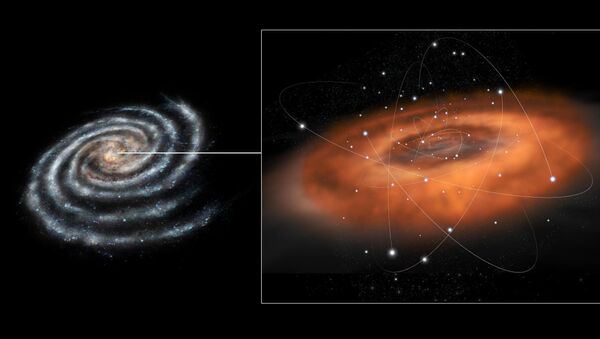A supermassive black hole, which scientists note hides in the centre of our galaxy in an object called Sagittarius A*, recently began consuming enormous amounts of matter, The Guardian reported, citing astronomers from the University of California Los Angeles (UCLA).
According to the report, scientists have run a comparison of over 13,000 Sagittarius A* images taken over 133 nights by the Keck Observatory in Hawaii and the European Southern Observatory’s Very Large Telescope in Chile since 2003 and found that in recent months the object has become unprecedentedly bright.
“We have never seen anything like this in the 24 years we have studied the supermassive black hole,” said Andrea Ghez, a UCLA professor of physics and astronomy and senior author of the research. “It’s usually a pretty quiet, wimpy black hole on a diet. We don’t know what is driving this big feast.”
New transmission from The Starset Society: Sagittarius A, the supermassive black hole at the center of our galaxy, has emitted a large burst of infrared radiation brighter than anything ever produced by that black hole. https://t.co/DMqgIfXaEr pic.twitter.com/716wcdt1Q0
— Orbitan (@The_Orbitan) September 10, 2019
A black hole cannot be seen because not even light cannot escape its powerful gravity, but the matter surrounding the celestial object emits violent radiation as it accelerates inward. An increase in brightness indicates that additional matter is being consumed by the black hole. Astronomers cannot say what kind of matter is falling victim to Sagittarius A* beginning in May this year and whether the increased burn is an anomaly or permanent.
“The big question is whether the black hole is entering a new phase[ …] and the rate of gas falling down the black hole drain has increased for an extended period, or whether we have just seen the fireworks from a few unusual blobs of gas falling in,” said Mark Morris, a professor of physics and astronomy at UCLA and the paper’s co-senior author.
Scientists hypothesize that the matter could have originated from star S0-2, which passed near the black hole in 2018. Scientists say the Sagittarius A* could have stripped the star of a large amount of its gas, which reached the black hole this year. Another possible source is a pair of binary stars known as G2, which passed next to the black hole in 2014.
The black hole, located 26,000 light years away from Earth, is too far away to pose any danger to our planet, the scientists note.



